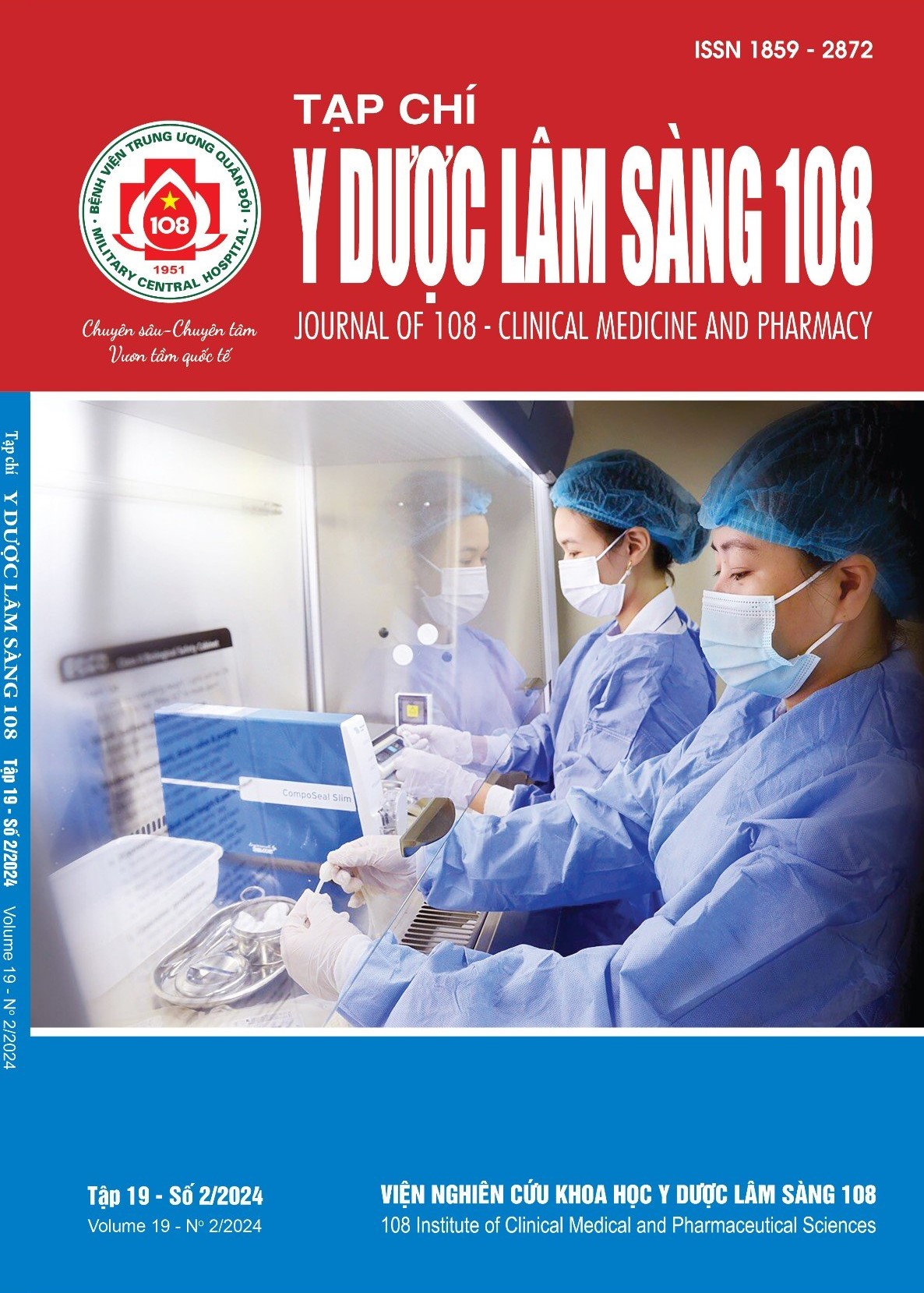Biến chứng khi sử dụng heparin theo phác đồ chống đông của Hệ thống y tế UMC trong kỹ thuật trao đổi oxy qua màng ngoài cơ thể
Main Article Content
Keywords
Tóm tắt
Mục tiêu: Đánh giá biến chứng khi sử dụng heparin theo phác đồ chống đông của Hệ thống y tế UMC (UMC Health System) trong kỹ thuật trao đổi oxy qua màng ngoài cơ thể (ECMO). Đối tượng và phương pháp: 80 bệnh nhân chạy ECMO được chống đông bằng heparin theo phác đồ UMC. Phương pháp: Can thiệp tiến cứu. Kết quả: Đa số BN được đặt canuyn theo phương pháp phẫu thuật (73,7%), tỷ lệ sống xuất viện là 43,8%. Giá trị ACT trung bình là 179,3 ± 8,8s với liều heparin TB 10,8 ± 5,1UI/kg/h. Tỷ lệ biến chứng chảy máu là 55%, chủ yếu là chảy máu nhẹ (48,7%) và hay gặp nhất ở vị trí đặt canuyn ECMO (50%). Chảy máu thường xuất hiện ở ngày đầu của ECMO (61,4%). Xét nghiệm ACT khi chảy máu đa số ở nhóm > 200s (56,8%) với ACT trung bình khi chảy máu cao 201,6 ± 15,0s. Kết luận: Biến chứng chính khi sử dụng heparin theo phác đồ UMC là chảy máu, tuy nhiên chủ yếu là chảy máu nhẹ tại vị trí đặt canuyn ECMO, xuất hiện ở ngày đầu của ECMO và chủ yếu xảy ra khi có xét nghiệm ACT cao hơn 200s. Không có sự khác biệt về tỷ lệ tử vong giữa nhóm chảy máu và nhóm không chảy máu.
Article Details
Các tài liệu tham khảo
2. Zeibi Shirejini S, Carberry J, McQuilten ZK et al (2023) Current and future strategies to monitor and manage coagulation in ECMO patients. Thromb J, 21(1): 11.
3. Bembea MM, Annich G, Rycus P et al (2013) Variability in anticoagulation management of patients on extracorporeal membrane oxygenation: An international survey. Pediatr Crit Care Med 14(2): 77-84.
4. Colman E, Yin EB, Laine G et al (2019) Evaluation of a heparin monitoring protocol for extracorporeal membrane oxygenation and review of the literature. J Thorac Dis 11(8): 3325-3335.
5. UMC Health System (2016) Adult ECMO Heparin Infusion Guidelines. https://apps.umchealthsystem.com/forphysicians/medicalorders/Ref%20-%20Adult%20ECMO%20Heparin%20Infusion%20Guidelines.pdf
6. McMichael ABV, Ryerson LM, Ratano D et al (2022) 2021 ELSO Adult and Pediatric Anticoagulation Guidelines. ASAIO J 68(3): 303-310.
7. Laverdure F, Louvain-Quintard V, Kortchinsky T et al (2016) PF4-heparin antibodies during ECMO: incidence, course, and outcomes. Intensive Care Med 42(6): 1082-1083.
8. Mazzeffi MA, Tanaka K, Roberts A et al (2019) Bleeding, thrombosis, and transfusion with two heparin anticoagulation protocols in venoarterial ECMO patients. J Cardiothorac Vasc Anesth 33(5): 1216-1220.
9. Đào Xuân Cơ (2016) Đánh giá biến chứng khi sử dụng heparin trong kỹ thuật tim phổi nhân tạo (ECMO) tại Bệnh viện Bạch Mai. Y học Việt Nam, Tháng 11- số 1, tr. 151-155.
10. Raasveld SJ, Karami M, Schenk J et al (2023) Transfusion of red blood cells in venoarterial extracorporeal membrane oxygenation:
A multicenter retrospective observational cohort study. Transfusion 63(10): 1809-1820.
11. Krueger K, Schmutz A, Zieger B et al (2016) Venovenous extracorporeal membrane oxygenation with prophylactic subcutaneous anticoagulation only: An observational study in more than 60 patients. Artificial Organs,
12. Yeo HJ, Kim do H, Jeon D et al (2015) Low-dose heparin during extracorporeal membrane oxygenation treatment in adults. Intensive Care Med 41(11): 2020-2021.
13. Glick D, Dzierba AL, Abrams D et al (2015) Clinically suspected heparin-induced thrombocytopenia during extracorporeal membrane oxygenation. J Crit Care 30(6): 1190-1194.
 ISSN: 1859 - 2872
ISSN: 1859 - 2872
